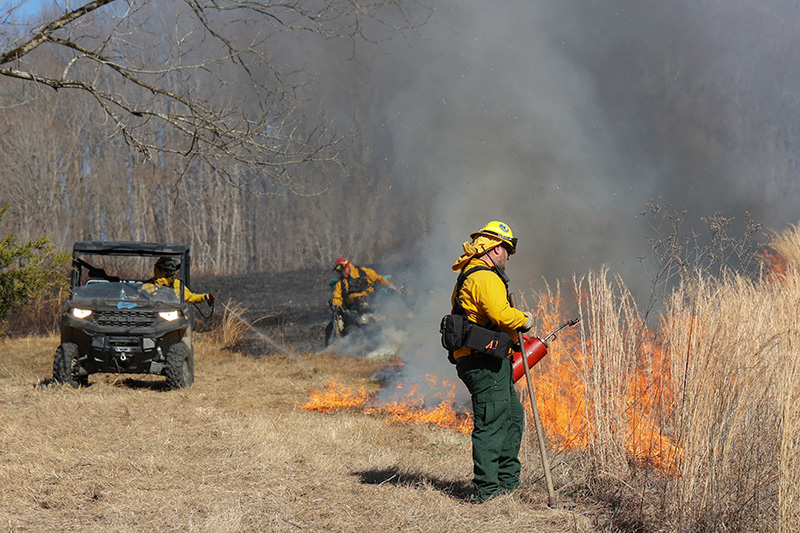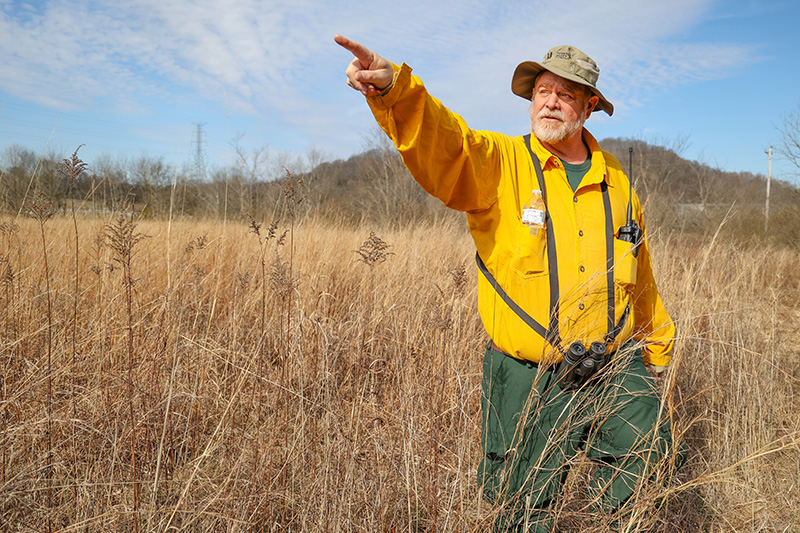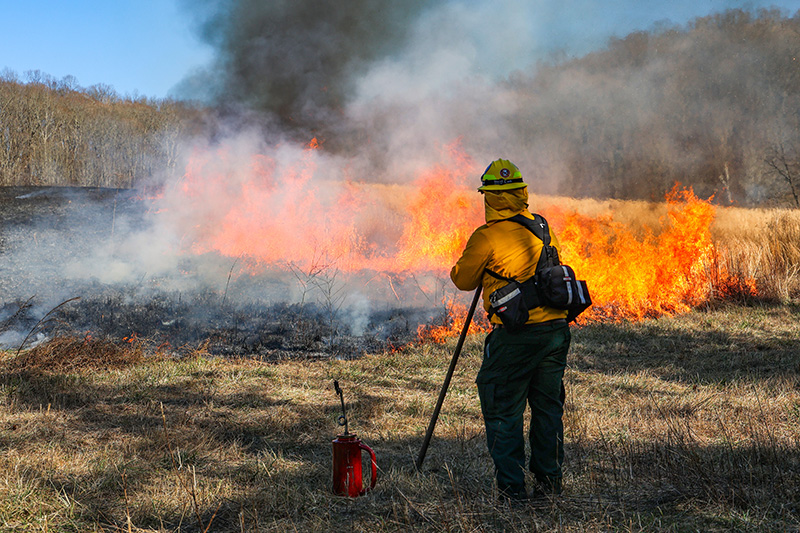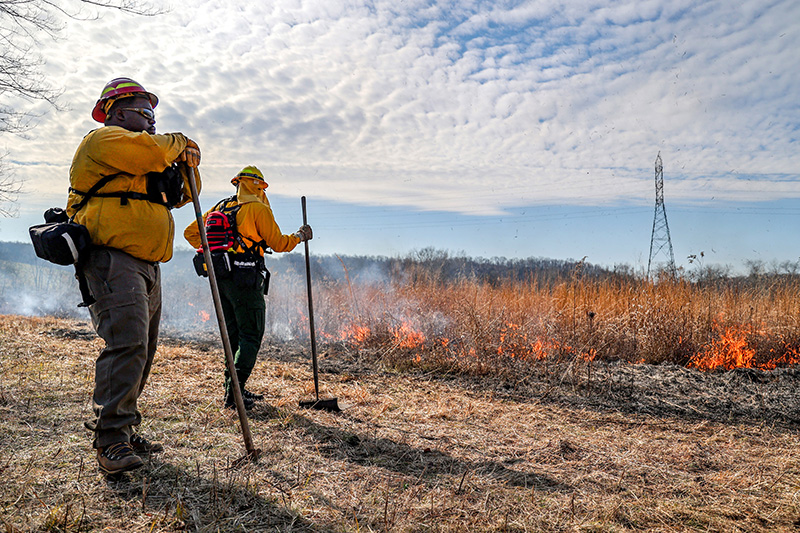TENNESSEE VALLEY-Plumes of smoke billowed against the blue winter sky as flames snaked to the edge of a grass field.
The air shimmered with rising heat.
“I’m pretty satisfied with that,” said Drew Lyles, Tennessee Valley Authority watershed representative and burn boss for the day.
Mike Sweda, also a watershed representative and fire crew member, nodded as he skimmed the grass tops with the nozzle of the drip torch, a narrow metal canister filled with fuels.
Flames streamed behind him.
The other six members of TVA’s fire crew took their places around the field below Normandy Dam. Soon puffs of smoke rose and fingers of fire snatched at stands of native gama, Indian and bluestem grasses.
Then with a whoosh, the fire blazed.
It rose to a wall of flame that crackled, spiraling into smoke tornadoes that blocked out the sun. In its wake a blackened moonscape of charred grasses smelled sweet like roasted grain.
Along with dozens of other prescribed burns each winter, this day was part of a long-term effort to restore fire to TVA lands and to its rightful place in the Valley.
“We’re trying to bring back what used to happen,” Damien Simbeck, TVA senior program manager in Natural Resources, said. “This is what the plant communities are used to. This is how they normally grow.”

TVA burn crew members Drew Lyles, Zackary Evans and Mike Sweda move in unison along an active burn site near Normandy Dam.
Feeding the Fire
As the fire settled into an even burn, the fire crew walked with it, staying safe in the already-burned area they called “the black” at the flame’s edge. They stood with radios ready and tools at hand.
Sweda’s voice crackled through the radio: “I’ve lit all the way down to the southwest corner.”
“OK, copy that,” Lyles said.
“We’ve got a little bit of drift,” Sweda squawked.
Lyles looked intently toward the hidden corner of the field. “Copy that. Is it more than Josh and Zack can handle?”
After a pause, the radio crackled again. “No. We’re good.”
And they were, because they had planned for all variables. They’re specially trained to run a prescribed burn, from writing a burn plan to constantly communicating and meticulously monitoring humidity, wind speed and temperature.
The eight-member crew at Normandy Dam in middle Tennessee have very different day jobs within TVA’s Natural Resources group.
Some manage aquatic weeds, while others write permits for people building on shorelines. But they come together to conduct prescribed burns on TVA reservoir lands, forests and agricultural fields.
On this day, they wore bright green and yellow fire-resistant Nomex pants and shirts, thick-soled boots, helmets and metallic fire-shelter backpacks. They carried flappers – rubber mats on handles – and flat rigid-toothed rakes, called Mcleods, to cut and tamp the ground. Some carried Pulaskis, versatile half-axe, half-adze tools with just the right heft to chop roots and skim surface debris.
Before setting roaring fires on two grassland fields, Lyles had led his crew through the burn plan and weather conditions.
Relative humidity around 40%. Just enough moisture in the air for a slow and steady burn. A temperature forecast for the 60s. Light and variable winds.
“So (the weather’s) setting up really, really nicely for us,” Lyles said. “That’s encouraging.”

TVA Natural Resources senior program manager Damien Simbeck points toward a fire break along a grass field as his team manages a prescribed burn.
Shifting Strategies
It’s also encouraging for grasslands that used to grow across TVA’s seven-state service area, and whose story has been written by fire since prehistoric times.
Fire incinerated invasive plants and let deep-rooted native grasses grow.
Those native plants, in turn, held tight to the soil, reducing erosion into rivers and easing floods.
And the grasses hosted wildlife.
Mice grew plump on Eastern gamagrass seeds. Elk and bison waded in chest-deep tangles. Quail crouched under cover from hunting coyotes, and intertwined stalks of grass made tents for ground-nesting birds.
Then everything changed.
With European settlement, grasslands began to disappear.
Native Americans who burned land to create open hunting grounds, fields and river cane breaks were largely driven off their lands, and lightning-set fires were squelched.
TVA and other federal agencies, who used to have dedicated fire crews, changed course.
“The fear of wildfire (and) the Smokey the Bear campaign made fires taboo,” Simbeck said.
Without regular, low-intensity fires, native grasslands disappeared.
Dead grasses and fallen limbs built up, creating dangerous piles of dry material that would burn out of control, hot and fast if wildfires accidentally ignited.
On top of that, Simbeck explained, people planted fields of fescue grass that required regular mowing and fertilizing. The roots didn’t stop soil or fertilizer from eroding into rivers.
“(Fescue)’s not a good field for me,” Simbeck said, taking the perspective of a grassland animal. “I can’t hide in it from predators, whereas the native grasses are clumps with spaces in between.”

Mike Sweda stands at the lower hem of a grass field during the prescribed burn.
Return of Fire
When TVA’s resource managers began restoring native grasses in the early 2000s, it meant rethinking ways they had managed and maintained land.
“Mowing doesn’t meet our goals of improving diversity and native vegetation on our public lands,” Anthony Summitt, TVA senior manager in Natural Resources and Recreation, said.
And mowing is more expensive and labor-intensive.
TVA began using fire again around 2010, Simbeck said. “It’s a lot easier to burn a hundred-acre field than to bushhog it to keep it open grass.”
By bringing prescribed fire – and native grasses – back to TVA-managed lands, managers can prevent erosion and use less fertilizer, both of which keep rivers and reservoirs algae-free and healthy, Lyles said.
“(Controlled fire) is a great tool to help us meet the goals laid out in TVA’s Natural Resource Management Plan,” Jimmy Lemmond, TVA recreation manager, said.
TVA’s prescribed-fire teams partner with federal, Tribal and state agencies, universities and others to accomplish their goals.
“It’s a cooperative way of managing land that’s very efficient,” Lemmond said. He grinned. “And it’s just fun.”

TVA burn crew members Kelvin Young and Drew Lyles monitor a prescribed fire near Duck River in middle Tennessee.
The Future and Fire
The effort to restore the land for springtime grass plantings went exactly as planned.
After several hours, crew members zoomed in from the corners of the second burn field soot-streaked and sweaty.
“That was awesome,” Lyles said. “I’m not sure it could have gone much better. Really good teamwork.”
Today’s crew – and the 30 or so TVA employees certified for prescribed fires who work throughout the Tennessee Valley – will continue to burn lands through March and in late fall through spring each year as weather conditions allow.
The future will likely bring more days like this.
“At the rate we’re going with planting native grasses and trying to get more and more habitats established, we’re … going to be doing a lot of burning,” Simbeck said.
“And that’s a good thing. The more we burn, the more diverse habitat we’ll have on TVA property.”








Media Release/TVA Newsroom


